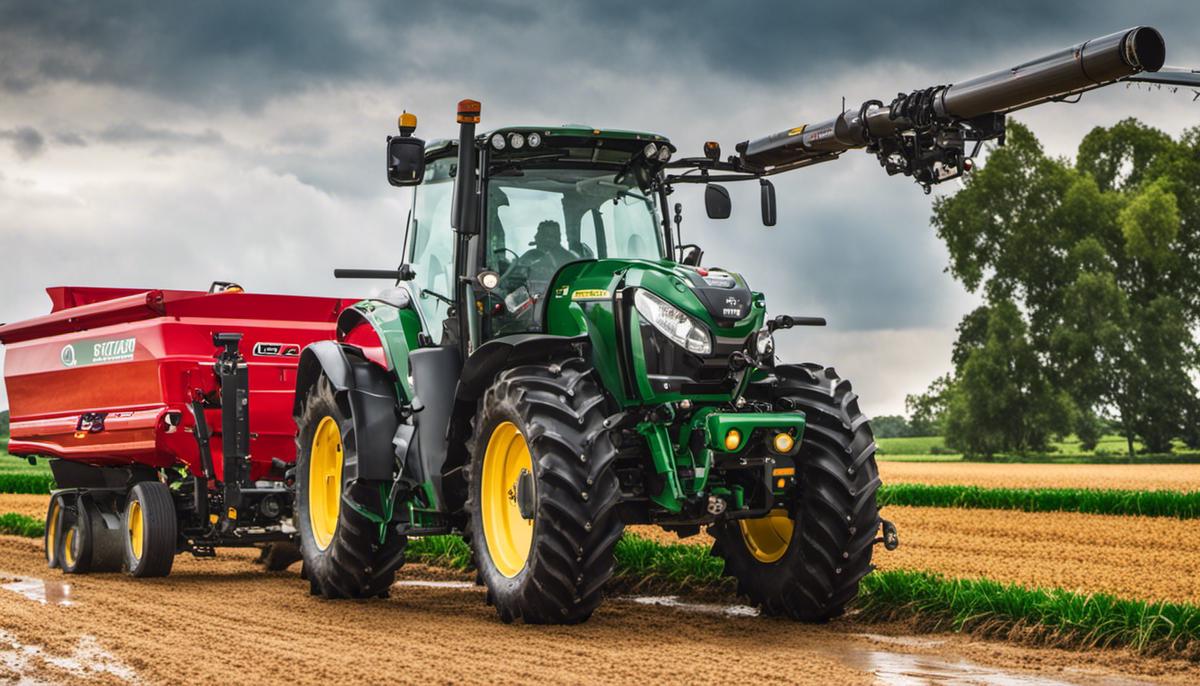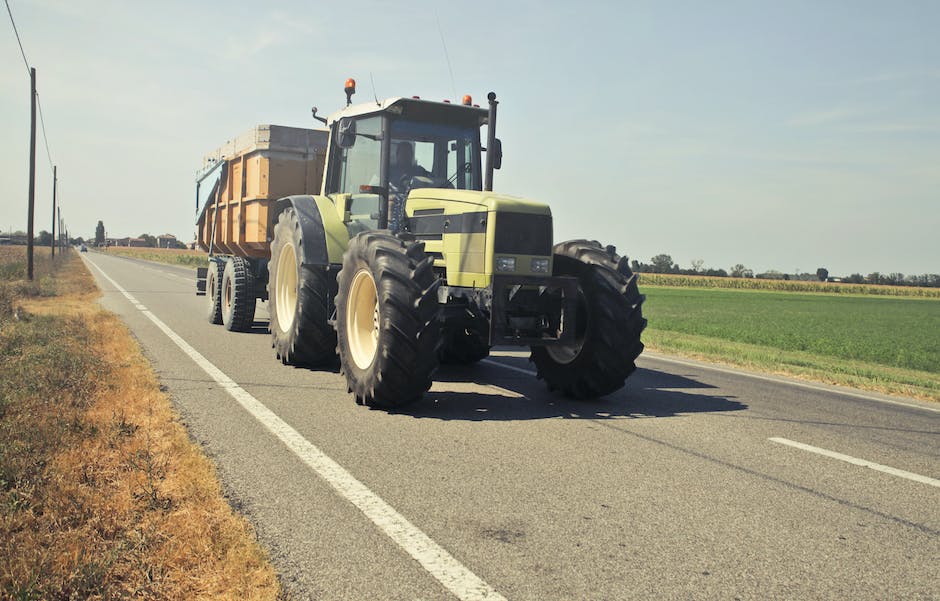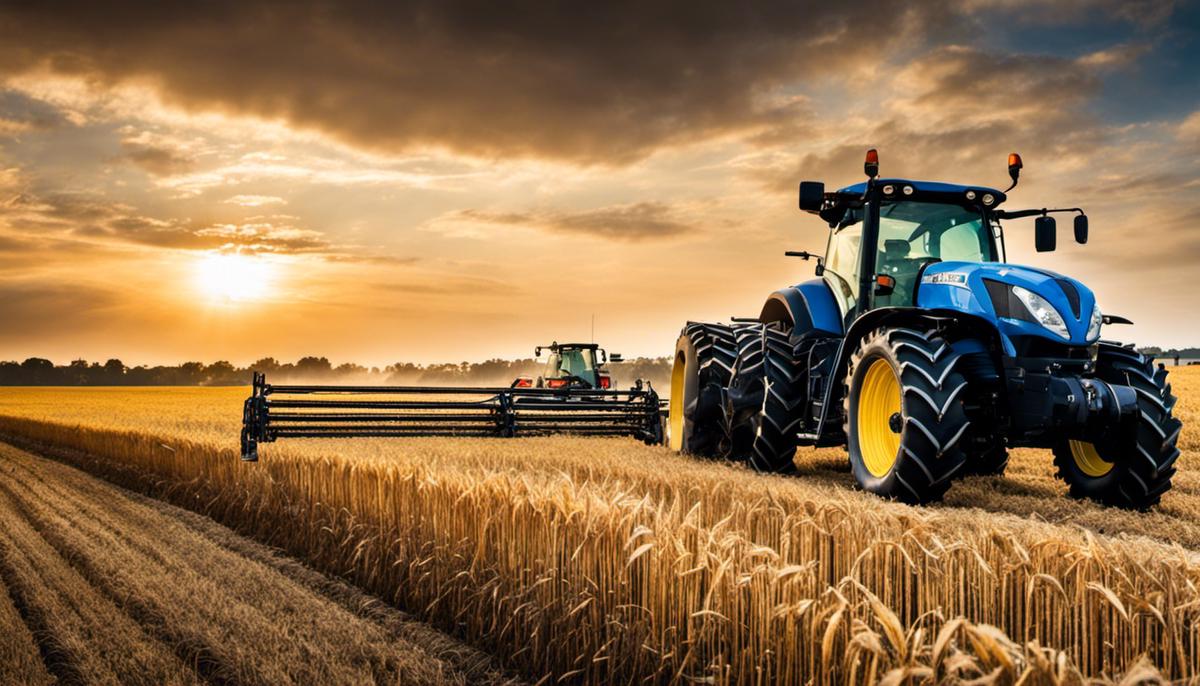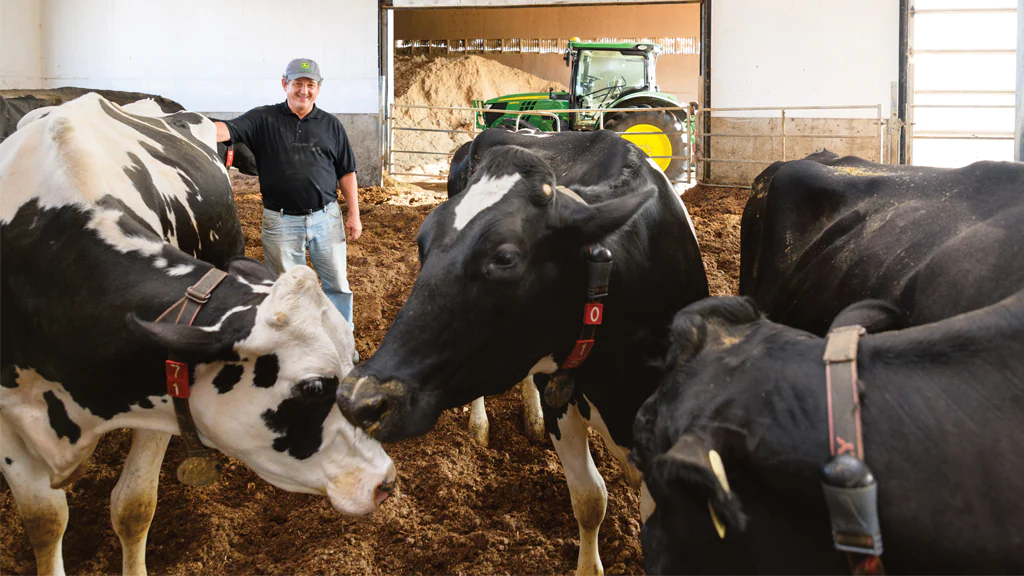

Agridisk
Egypt - Alexandria

5 Golden tips for choosing the right agricultural machinery
Description: As a cornerstone of civilization's growth, agriculture and the skillful stewardship of land and resources are integral to our society's health and prosperity. However, it is no longer sufficient to rely on traditional methods alone. With vast advancements in technology and engineering, modern agriculture presents an array of machinery and methods aimed at increasing productivity, reducing labor, and promoting sustainable farming practices. The aim of this discourse is to enlighten the general public about the diverse types of agricultural machinery available, their specific purposes, and how to choose the appropriate machinery for their farming needs. We will explore the challenges and strategies involved with balancing costs and effectiveness, and address the role of innovation and evolving technology in driving agricultural advances. Lastly, we'll delve into maintaining machines for longevity, discussing safety considerations associated with their use, and the importance of operator training. Agricultural machinery, a vital cornerstone of modern farming, ranges from simple hand tools to sophisticated and robust mechanized equipment. Through intricate study, one can identify distinct variations amidst these farming aids derived from specificity in their function, design, and technology. Traditional farms were characterized by the prevalence of essential handheld tools such as hoes, shovels, forks, and rakes. Yet to cope with increasing agricultural demands and ensure sustainable farming, a shift towards mechanized farming was crucial. Hence, the advent of technology transformed these manual tools into innovative farm machinery ‒ tractors, harvesters, balers, plows, seeders, sprayers, and many more. Mechanized tractors, unequivocally the backbone of a modern farm, differ significantly from handheld tools. These high-tech machines are equipped with powerful engines, designed to pull a variety of farm implements, thus streamlining farming to a remarkable extent. Specific tractor sub-types engineered for distinct agricultural tasks include row-crop tractors for large-scale farming and utility tractors for diverse tasks, reflecting the sector's sophisticated adaptation of technology. Combine harvesters, another exemplar of advanced agricultural machinery, highlight varied operational mechanics. Instead of manually reaping, thrashing, and winnowing crops, this all-inclusive automaton does it all in one fell swoop. Consequently, the design mechanics, energy requirements, and level of sophistication distinctly segregate harvesters from simple farm tools and even other machinery. Contrarily, agricultural implements like plows, seeders, and sprayers, despite their mechanization, could be deceptively similar to their handheld predecessors in functionality – maintaining their primary roles in soil cultivation, crop sowing, and pesticide dispersion respectively. Nevertheless, on closer examination, their operative mechanics, efficacy, and scale differentiate them fundamentally as sophisticated machinery. Meanwhile, highly specialized machinery such as cotton pickers, balers or disk harrows further extend the gamut of agricultural machinery types. Albeit niche, these machines underscore the vast spectrum of mechanization in agriculture, again emphasizing core differences in design, function, and technology. In essence, the complex expanse of agricultural machinery sculpts the landscape of modern farming. From humble handheld tools to multifaceted machinery, each equipment signifies a unique aspect of agricultural operation and sophistication. Deconstructing and understanding the fundamental differences among them facilitates a deeper appreciation for the technologically immersive world of agriculture, a reminder of humanity's entwined relationship with soil and sustenance. The realm of agricultural machinery continues to evolve and adapt, striving to conquer challenges thrown by nature, and standing testament to human ingenuity and problem-solving ability. To make an accurate assessment of the machinery necessities for a particular agricultural operation, a myriad of factors must be taken into consideration. Paramount to making these determinations are four core components: the nature of the crops, the size of the farming operation, the region's climate, and the condition of the land. The type and variety of crops cultivated substantially influences the type and number of machinery required. Crops such as rice demand distinct equipment like rice transplanters and harvesters, while wheat cultivation necessitates machinery such as reapers and threshers. An acute understanding of the crops' growth habits, harvesting times, and post-harvest treatment is critical in identifying the suitable machinery necessary to optimize crop yield and streamline farm operations. The size of a farming operation also has a critical bearing on the machinery requirements. As farms increase in size, one might observe a concomitant rise in the scale and complexity of the machinery. Larger farms often necessitate oversized tractors, powerful combine harvesters, and colossal seed drills. These farms may also require machinery for irrigation and drainage, considering that manual or traditional systems might fall short in efficiently managing extensive acres of farmland. The local climate conditions also bear significant implications for machinery requirements. In regions with high rainfall, there may be a greater need for drainage equipment to prevent soil erosion and waterlogging, which could adversely affect crop growth. Similarly, areas with intense sunlight may necessitate irrigation systems to maintain optimum soil moistness. Machinery must also be robust enough to operate effectively under the specific weather conditions in which they are to be used, thus affecting the choice of machinery, its make, model, and additional features. Lastly, the condition of the land and soil type profoundly impacts the selection of machinery. Rocky and hard soils may command more robust and high-powered machinery for cultivation compared to loose, sandy soil. Moreover, the topography of the farm could impose limitations on the size and type of machinery that can be employed, with level lands able to accommodate larger and heavier machinery compared to hilly or uneven terrains. Upon careful scrutiny of these factors, focused investigation further necessitates studying the efficiency of the machinery, considering fuel consumption, durability, and associated maintenance costs. Equally important is staying abreast of technological advancements in agricultural machinery to seize opportunities that could increase efficiency and productivity in farming operations. In sum, determining the specific machinery requirements for an agricultural operation essentially hinges on a comprehensive understanding of the interplay between various crop species, the extent of the operation at hand, local weather patterns, and landed conditions – all while keeping a sharp eye on strides in technology and scientific breakthroughs. Transparent, data-driven decisions aligned with continual learning foster the cultivation of an efficient, sustainable, and productive farming operation. Harnessing the right machinery is an integral facet of this pursuit. Balancing the intricacies of cost, effectiveness, and environmental impact forms the trifecta of considerations when selecting agricultural machinery. It's a delicate interplay where each aspect must be optimized to ensure a farming operation's overall efficiency and long-term viability. From an economic standpoint, the correlation between the cost of agricultural machinery and the farm’s profitability is direct and significant. Choosing machinery includes not only the initial purchase but also upkeep expenses - fuel consumption, repairs and maintenance, insurance, and eventual replacement costs. Running a cost-effective farm operation would necessitate, above all, an investment in machinery that is reliable, durable, and reasonably priced. Monitoring machinery efficiency, beyond a mere measure of fuel intake, involves a detailed understanding of how effectively these machines can perform tasks in proportion to resources expended. High operation efficiency remains the ultimate aim - machinery should not only fulfill its role competently but do so within reasonable resource usage parameters. Advanced technology is often equated with high efficiency. Newer technologies can provide improved performance, but the capital investment may not always justify the short-term efficiencies gained, necessitating a broader temporal perspective in decision-making. Simultaneously, environmental considerations are of immense importance in modern agricultural machinery choices. The demand is for low-emission machinery that is less detrimental to the environment. The carbon footprint of a machine is a significant factor in the overall environmental impact of agricultural practices, encompassing not only the toxins released during operation but also production, transportation, and disposal. Hence, a conscientious farmer who wishes to prioritize environmental sustainability must remain abreast of advancements in green farming technologies, potentially including machinery powered by renewable energy sources such as biodiesel and solar power. Another environmental challenge extends to machinery’s physical impact on soil and fields. Excessive or incorrect use of heavy machinery can lead to soil compaction, altering the soil's structure and negatively affecting crop growth. Thus, the machinery selection process must take into account soil type and land conditions and incorporate practices like crop rotation and correct machine handling to minimize disruptive environmental impacts. Navigating these multidimensional aspects of agricultural machinery involves a thorough understanding of farm-specific needs, the machinery market, and evolving technology trends. Further, a firm commitment to developing a sustainable, environmentally responsible farming operation is indispensable in our rapidly changing world. Targeted research, transparent decision-making, and a willingness to embrace innovation hold the key to cultivating an optimally balanced and sustainable agricultural operation. Continuing the discourse on the profound influence of technology on agricultural machinery, it becomes essential to delve into the exploration of more advanced forms of machinery that underline the progression in this sector. A significant lucent example is the advent of autonomous and semiautonomous tractors. Such machines redefine the realm of mechanized farming by minimising the need for human-driven operation catering to tasks such as plowing, seeding, fertilizing and harvesting. Employing Global Navigation Satellite Systems (GNSS), these machines ensure precision in their operation deadlines, thereby reducing waste, enhancing productivity, and ensuring a lower carbon footprint. The role of technology becomes even more accentuated when discussing the integration of telematics in agricultural machinery. This digital technology helps farmers manage their fleet remotely, tracking the machines' performance, location, fuel efficiency, and operational hours. Recent advancements have even enabled predictive measures, such as anticipating repairs and recognising inefficiencies in real-time. In terms of innovation, nothing overshadows the potential of nanotechnology and biotechnology in this field. Nanotechnology, with its capabilities of manipulating matter at an atomic level, can improve the precision of fertilisers, pesticides, and irrigation systems, reducing the amount of wasted resources, benefiting both the environment and the economy. In parallel, biotechnology contributes greatly to the design of newer agricultural machines which can handle genetically modified crops or 'Transgenic crops'. These crops, created for resistance to pathogens and herbicides and enhanced for better nutrient profiles, necessitates machinery capable of specific and unique handling. Robotics and artificial intelligence are two other compelling narratives of this digital transformation. Robots, designed for specific functions such as milking cows, pruning vines, picking fruits, or even planting seeds, have considerably boosted efficiency while reducing labor costs. Meanwhile, drone technology is emerging as a consequential player in modern agriculture. Utilizing imaging spectrometry, drones can analyse the health of vegetation, the moisture content of soil, and detect pest invasions or fungal infections, providing essential data for farmers to enhance the overall productivity. Unearthing the full potential of these technological advances also demands attention to the accompanying challenges. The susceptibility of various farms to accommodate these technologically sophisticated machines often differs based on the geographical locality, socio-economic factors, and the existing infrastructure. However, the pressing need to feed a growing population calls for ramping up agricultural production, making it imperative to face these challenges head-on and move towards a technologically driven farming ecosystem. Lastly, training and education cannot be underestimated in this transformative journey. Equipping farmers with the knowledge to utilize these machines correctly, comprehend the encrypted analytical data, troubleshoot minor technical issues and understand the technology's sustainable potential is crucial. Agricultural advisories and digital literacy programs can play a cardinal role in making this technological transition seamless. In conclusion, the intricate dance between technology and agricultural machinery has only just begun. It is a ballet set to the rhythm of rising global challenges, socio-economic strains, and environmental concerns. The resonance of this performance is bound to echo in the future, sketching a landscape of agricultural abundance, efficiency, and ecological responsibility that will ultimately serve to safeguard our planet. Moving to an area quintessential in chasing safety and stability is that of machine maintenance. This, much like proper operation, necessitates an intimate knowledge of the agricultural machinery in question. Scrutinizing any indications of machine failure, for instance unusual noises, vibrations, or leakage, can flag emergent issues. The regularity of maintenance checks, therefore, is paramount and should be considered no less than a prerequisite to operating such machinery. Encouraging meticulous machine maintenance is the frequency of machine cleaning. Like the human body, machines perform far more efficiently when kept unblemished from external factors – in this case, dust and grime. These can infiltrate the machine’s smallest crevices and dampen its functionality. Thus, regular cleaning and lubrication are fundamental to preserving the machinery's lifespan and ensuring its optimal functioning. Another safety measure to be noted is the familiarity and compliance with the regional and national regulations regarding agricultural machinery utilization. Every piece of machinery needs to answer certain safety standards before it is allowed to operate on the fields. Ignorance or disregard of these regulations can precipitate accidents and incidence of equipment malfunction, making this adherence not only a matter of legality, but also of safety. Lastly, one must shine a former spotlight upon the revolutionary advent of advancements in farmer personal protective equipment (PPE). Implementation of enhanced helmets, gloves, and boots have greatly impacted physical safety during machinery operation. Combining technological advancements with traditional PPE yielded clothing with protective sensors and cooling technology, drastically augmenting operator safety and comfort. Collectively, these considerations form a sound argument elucidating the prime importance of machine operation awareness, regular maintenance, routine cleaning, regulatory compliance and the use of personal protective equipment. As we trudge forward in our exploration and refinement of agricultural mechanization, our handling of machinery persists to be as important as the machinery itself. Through the amalgamation of these practices, we can continue to sustainably and safely propel the advancement of agricultural productivity and efficiency. Throughout this discourse, we have navigated the highly technical and complex world of agricultural machinery, unraveling the unique attributes and purposes of each type. It is evident that meticulous assessment of a farm's specific requirements is crucial in identifying the most beneficial machinery. While evaluating the potential machines, cost, efficiency, and impact on the environment must be considered to strike a balance that sustains both productivity and the land. Furthermore, the advent of AI systems, data analytics, and precision agriculture has revolutionized the sector, offering ample opportunities for efficiency and sustainability. However, despite the promise of these advanced technologies, they are only as effective as their handling. Therefore, ongoing machine maintenance and rigorous safety practices, complimented by competent personnel training, are indispensable for maximizing the return on machinery investments. Thus, the art of choosing and operating agricultural machinery signals a vital stride toward the future of effective and responsible farming. There are many methods of agriculture and develop every time, and that made them many types in the markets, and also their prices are very high, and there are medium prices, and of course, the expensive machines are better in terms of production and the means of processing seeds and choosing the right ones, and also depending on the area of the land or your project for agricultural production , animal, or domestic production, so how do you choose the right machine for you, in this article you will know how to choose the right machine for you. Whether you are looking for agricultural equipment, animal husbandry equipment, or any other equipment, there are golden tips in order to choose the right machine for you and you must follow it, as follows: 1- Write down exactly what you need, from harvesting equipment or tools, or trucks. 2- Determine your budget. When choosing, you must be aware of your budget, in order to know what you can buy from the tools. 3- Get to know the machines well, not every expensive is good, so you must know the capabilities of the agricultural machine, and how it can achieve your crop, or your production in general. 4- Test the equipment, because the price of agricultural machinery is very expensive, so you must try and test it well, and test all its features, because it will be a very important factor in increasing your production. 5- Buying from a reliable merchant, the machines are very expensive, and you must buy them from a place that has a guarantee, and can carry out the maintenance process, and also follow up on customer reviews about it.Understanding Different Types of Agricultural Machinery
A Comparative Study of Diverse Agricultural Machinery: Core Differences and Mechanisms

Assessment of Farm Requirements
Deciphering the Specific Machinery Requirements for a Successful Agricultural Operation

Agricultural Machinery: Efficiency and Trade-offs

The Role of Technology and Innovation in Agricultural Machinery

Maintenance and Safety considerations in utilizing agricultural machinery
Shifting our gaze towards more complex topics, complicating the clear-cut issues of safety and durability when engaging with agricultural machinery, one finds the necessity to examine the operator's role in machine functionality. Seldom is a machine's design flaw entirely attributed to faulty mechanics; rather, it arises from operator misuse. Machines are created with intense precision, and their performance necessitates similar preciseness from the operators. Thus, knowledge and training are crucial for an operator's interaction with complex machinery, engendering not only the optimal performance of the machine but also ensuring its longevity.


Golden tips for choosing the right agricultural machinery